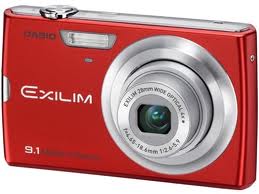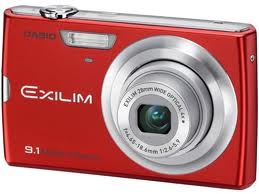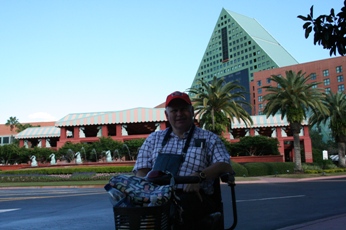

Picture Taking

If you intend on taking a lot of pictures of your vacation travels then it is better to be using a digital camera as opposed to a film camera. With a film camera you have to buy the film (and lots of it), buy x-ray protective packaging (although airports claim their x-ray machines are film safe), and then pay for processing for both the good, bad and ugly pictures.
With digital cameras, storage cards can be reused and reused and you are not worried about all the bad & ugly pictures as you can simply delete those later. All you need is enough storage memory cards to cover all of the pictures you will take for the duration of your travels.
I usually travel with a laptop and copy the pictures at the end of the day over to the hard drive in the laptop and start with an empty memory card each day.
What is the ideal camera for vacation pictures?
- The higher resolution the camera you get the better (will explain further into this article}
- Good Optical zoom range, I avoid any digital zoom as you lower the resolution when using a digital zoom, better to use the computer to zoom in / crop then using a digital zoom.
- SLR (Single Lens Reflex) is always the best but of course a lot more expensive to buy than the standard point and shot cameras. I have a cannon rebel XT.

SLR High Quality SLR Camera
Interchangeable lens, you actually view thru the lens so what you see if what you get. Higher quality optics. Rapid fire capabilities. Usually has auto or semi-auto settings as well as the capabilities of using completely manually adjusted custom settings.

Standard point and shoot camera
Slow trigger. No lens interchangeability. Often limited optical zoom capabilities. Often no rapid fire capabilities.
So which ever type your budget will allow, a high resolution camera will be one of the considerations when buying (the mega pixel stats). I always set the camera at the max. resolution available for that camera, lower resolution will get more pictures but lower quality. If you can afford a SLR high quality camera then that is the way to go.
Picture Situations…
Lets say you have a subject off in the distance, use you optical zoom but I would not recommend you using the digital zoom.

I was in a moving tour vehicle with the lens fully zoomed in.

I copied the pictures to the computer, and using Microsoft office picture manager used the crop tool to pick the area of the lion head and this was the result. There is other software that can be used to crop.
Now here is where a higher resolution camera helps, when you use a digital zoom on a camera you are essentially cropping in the camera itself, I much rather never use the digital zoom (use optical zoom only) and then use the computer for any cropping. When you crop you are taking only a portion of the original picture, in doing so you lower the resolution because you are taking only a portion of the whole picture, you will notice the file size is smaller when you resave after cropping. Now cropping the same picture that was taken with a 6 mega pixel will be lower resolution than cropping from a picture taken at an 8 or 10 mega pixel camera. Dropping the resolution enough and the picture becomes distorted. Resolution will drop by cropping but the higher the resolution you started with before the crop and you still will have better quality left (resolution) then cropping from a picture that was first taken at lower resolution.
Use of the camera flash….

This picture was taken without the flash

This picture was taken with the flash
Both these pictures was taken within a minute of each other in the daytime. I was in a shadow which made the background brighter which made me darker, to compensate when the flash was used it provided enough light that both I and the background could easily be seen.
Cameras with automatic flash may see only the background and not trigger the flash unless it is set to force it to go off. For this effect to work the subject (me in this case) must be within flash range which is under 10 – 15 feet, I recommend less than 10 feet away.
In fast moving action or if you are trying to shoot something between a crowded area, or waiting for a celebrity to look towards you just for a second, you may want to try to use rapid fire, but usually is only effected on SLR’s. You will have a certain amount of pictures that you may want to delete later but some will be perfect. An approach you will would never do with film, but with digital using digital memory, so what if 8 of the 15 shoots are no good, it is not like you are paying for processing.
Night time pictures without a flash – you will have to experiment to find what works the best with your camera. A Disney magic kingdom parade at night you are forbidden to use flash photography so you have to make sure the flash is set to not go off at all, and I used rapid fire on it, now depending on light intensity on my SLR the shuttle will slow down on semi-auto settings but I use rapid fire for the whole parade, and yes I got a portion of blurry shots but I also got perfect pictures out of the mix.
For indoor shows where photography is allowed on condition there is no flash, for auto or semi-auto camera settings, if need be catch the edge of a spot light in the shot, that will speed up the shuttle enough to get a sharp picture, now sometimes that means zooming out to do that, but you can crop the picture later to just get what you want as long as the resolution is high enough to still have reasonable quality after the crop.
Also for SLR’s in some lighting conditions you may have to switch to manual focus, it is not easy to do with point and shoot cameras, so I consider that an option only with SLR’s.
I would recommend if taking a large amount of pictures to bring extra memory cards not just for capacity but if one card goes bad at least you have a backup. If some pictures got accidentally deleted or if the card goes bad, there is software such as rescue pro that will try and recover the pictures from the memory card, and this may work even if the card does not work properly in the camera itself. But such recovery software will not work direct from the camera, you must remove the memory storage card from the camera, and use a card reader connected directly to the computer. Recovery of formatted or accidental deletions or a card gone bad will only work if you stop immediately using that card, once you start taking pictures with the same card you overwrite those memory locations on that card making recovery impossible. Back in 2007 I had a card become unusable and was able to recover at least 2/3 of the pictures on it using ‘Rescue Pro’ software on the computer.
The next concern is battery life, taking large volume of pictures may not only mean filling the memory card but you may run out of power in some instances, so extra batteries / rechargeable may be a consideration.
I would also recommend carrying cameras on you and not in checked in luggage, it will however be required to pass thru airport x-ray machines. Have the camera turned off but make sure batteries are charged, occasionally security may ask to check to make sure it is a working camera but have it off when passing thru x-ray machines.
If you do have a film camera (as mentioned before I do recommend a digital camera for taking lots of pictures because of the cost factor), I would recommend that there is no film in the camera when it passes thru an x-ray machine, film should be in a x-ray protective bag (although again I will mention airports claim their x-ray machines are film safe). As an added measure you can ask that the protective x-ray film bag be hand inspected and they may grant your request, but they do have the final say. Also x-ray machines in foreign airports may not be as film safe as those in places such as the United States or Canada.
For information on how to do screen saves, click Screen Saves.
One additional note to consider when traveling to areas known to have a higher rate of crime which would would rather loose the expensive camera that takes the best pictures or the cheap point and shoot camera?
By: Donald Kerr